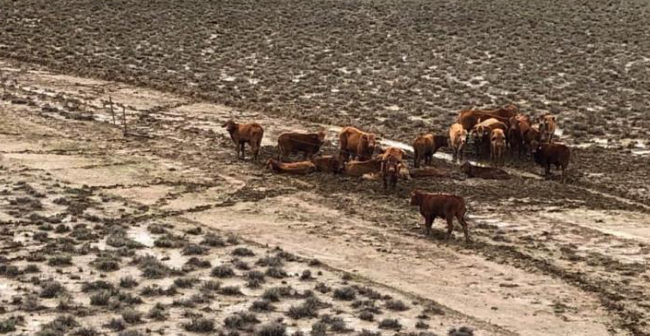
After seven years of drought, the cattle farmers in the Australian state of Queensland welcomed the rainstorms heading their way as a blessing. But now, after one of the most terrible floods in state history, a billion-dollar industry could be left in tatters.
Authorities estimate that nearly 500,000 cattle—worth about $213 million—have been killed by flooding in Queensland’s north since the rain began falling late last month. The downpours have ended but the dead cattle bodies remain, baking in the record-breaking summer heat. If not buried or burned, they will become a health danger. Video taken from overhead at one location shows scores of dead cattle huddled together amid the devastation.
Cattle farmers and industry experts say the worst could be yet to come. Australia’s beef industry is one of the country’s biggest economic drivers, with exports in 2017 worth $5.3 billion. The CEO of rural production Agforce Queensland, Michael Guerin, described the flooding as a “crisis”. “Although we won’t know the full extent of the livestock losses and infrastructure damage until the water fully leaves, it is certain that the industry will take decades to recover.”
Many of the cattle that survived can’t be reached since roads aren’t passable yet. Authorities have turned to air drops to provide feed, but the affected areas are so vast that they may not be able to reach all the animals in need. The Queensland government is providing emergency hardship assistance to those affected. Farmers are eligible for grants up to $53,000 but may need more to rebuild herds. Cattle farmer Jodi Keough told Seven News she expected to lose half her herd, adding that if authorities do nothing “we’re talking about a possible collapse of a primary industry in Australia.”
本时文内容由奇速英语国际教育研究院原创编写,未经书面授权,禁止复制和任何商业用途,版权所有,侵权必究!(作者投稿及时文阅读定制请联系微信:400-1000-028)
1.What did the cattle farmers in Queensland think of the rainstorms at first?
A It was terrible.
B It was great.
C It was troublesome.
D It was useless.
解析:选B。细节理解题。根据第一段第一句After seven years of drought, the cattle farmers in the Australian state of Queensland welcomed the rainstorms heading their way as a blessing.可知,在经历七年的干旱之后,昆士兰的牧民一开始将暴雨的来临看作是一件幸事。故选B。
2.What does the second paragraph mainly talk about?
A The long periods of rain and high temperature in northern Queensland.
B The amount of the dead cattle bodies after the rainstorms.
C The way of how to deal with these dead cattle bodies.
D The terrible cattle loss and potential danger of these dead bodies.
解析:选D。段落大意题。通读第二段的内容可知,此段主要介绍了洪灾造成的牛群损失和牛的尸体在高温下爆晒带来的潜在风险。故选D。
3.Which of the following is NOT the fact according to the passage?
A The terrible floods made the beef industry in Queensland suffered a great loss.
B Australia’s beef industry is the country’s most important economic backstop.
C Michael Guerin was worried about the country’s beef industry after the flood.
D The authorities are now facing enormous difficulties in their rescue efforts.
解析:选B。细节理解题。根据第三段第二句Australia’s beef industry is one of the country’s biggest economic drivers, with exports in 2017 worth $5.3 billion. 可知牛肉产业是澳大利亚最大的经济驱动力之一,而非最重要的经济支撑。故选B。
4.How do you understand the underlined sentence in the last paragraph?
A Cattle farmers like Jodi Keough are in desperate need of help from the authorities.
B Jodi Keough’s livestock loss has badly damaged the beef industry without any help.
C Only the authorities should be responsible for the beef industry’s revival.
D The beef industry in Australia will soon die because of the inaction of the authorities.
解析:选A。句意理解题。根据第四段最后一句的前半句Cattle farmer Jodi Keough told Seven News she expected to lose half her herd可知该牧民指出她可能会损失一半的牧群,结合画线句子的语境可知,她和该媒体正在谈论的内容即指的是上文提到的损失。类似这样的损失如果没有当局的帮助就会使整个牛肉产业崩溃,由此可知她的言下之意是像她这样的牧民急需政府的帮助。故选A。